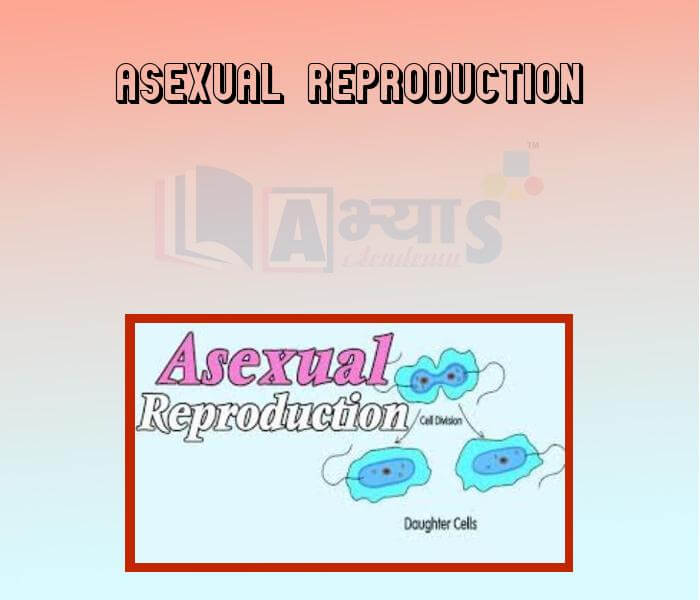Asexual Reproduction













Asexual Reproduction
Asexual Reproduction: The type of reproduction that takes place without the process of gamete (sex cell) formation is called asexual reproduction. As only somatic cells are involved it is also called as somatogenic reproduction. This process is very common in unicellular organisms and is said to be the simplest type of reproduction e.g. binary fission in amoeba, budding in hydra, spore formation in Rhizopus and fungus, vegetative propagation in flowering plants like rose etc. This type of reproduction takes place commonly in lower plants and animals, where the body is not very complex. There are different forms of asexual reproduction :
1. Fission : In this type of reproduction whole body acts as a reproductive unit. The nucleus of the unicellular parent organism divides into two followed by division of cytoplasm, resulting in two daughter cells of almost equal size. It is commonly seen in Euglena, Ameoba. Depending on the number of division, fission can be binary fission, longitudinal fission and multiple fission.
2. Fragmentation :These organisms are formed of cells and tissues but lack differentiated specialised tissue and organs. Such organisms are produce by breaking of theri bodies into small pieces called fragments. Each fragment is capable of developing inot a complete organism. Example :flatworm, echinoderm,sea anemones, filamentous green algae .
3. Budding : It involves production of a new individual form an outgrowth or small projecrtion, from the parent, called a bud. It is commonly seen in yeast, some protozoans and ceratin lower organisms like Hydra and sponges.
4. Regeneration : This is the abiltiy of an organsim to regenerate its lost part of the body which has been removed as an injury or by autonomy. Eg : Planaria
5. Spore formation : it is a common method of asexual reproduction in fungi and bacteria. The spores are produced in specialised strructures called as sporangium in case of fungi. Non - motile and non - motile spores are called aplanospores while the motile and flagellated spores are called as zoospores. The spore are libertaed after rupturing of sporangial wall.
6. Vegetative reproduction : It is the method in which parts other than seeds are used as propagules . They are classififed as natural and artificial method.
There are several methods of natural vegetative propagation . They are By root tubes, By underground modified stems, By runners, node of potato, Rhizome of ginger, corn of banana and bulb of garlic and onion, by leaf etc.
Artificial Method :
These are man made and develpoed by plant growers and horticulturist for commercial prooagation of crops. Some common methods are Cutttiing, Layering, Grafting, Plant tissue culture etc.
__________ is not an example or feature of asexual reproduction? | |||
| Right Option : B | |||
| View Explanation | |||
Identify from the following, a correct statement with reference to asexual reproduction | |||
| Right Option : B | |||
| View Explanation | |||
Reproduction is essential for continuation of _______________________ | |||
| Right Option : A | |||
| View Explanation | |||
Students / Parents Reviews [10]
It was a good experience with Abhyas Academy. I even faced problems in starting but slowly and steadily overcomed. Especially reasoning classes helped me a lot.

Cheshta
10thI have spent a wonderful time in Abhyas academy. It has made my reasoning more apt, English more stronger and Maths an interesting subject for me. It has given me a habbit of self studying

Yatharthi Sharma
10thIt was good as the experience because as we had come here we had been improved in a such envirnment created here.Extra is taught which is beneficial for future.

Eshan Arora
8thBeing a parent, I saw my daughter improvement in her studies by seeing a good result in all day to day compititive exam TMO, NSO, IEO etc and as well as studies. I have got a fruitful result from my daughter.

Prisha Gupta
8thMy experience with Abhyas academy is very good. I did not think that my every subject coming here will be so strong. The main thing is that the online tests had made me learn here more things.

Hiya Gupta
8thMy experience was very good with Abhyas academy. I am studying here from 6th class and I am satisfied by its results in my life. I improved a lot here ahead of school syllabus.

Ayan Ghosh
8thAbhyas Methodology is very good. It is based on according to student and each child manages accordingly to its properly. Methodology has improved the abilities of students to shine them in future.

Manish Kumar
10thAbhyas is a complete education Institute. Here extreme care is taken by teacher with the help of regular exam. Extra classes also conducted by the institute, if the student is weak.

Om Umang
10thOne of the best institutes to develope a child interest in studies.Provides SST and English knowledge also unlike other institutes. Teachers are co operative and friendly online tests andPPT develope practical knowledge also.

Aman Kumar Shrivastava
10thAbout Abhyas metholodology the teachers are very nice and hardworking toward students.The Centre Head Mrs Anu Sethi is also a brilliant teacher.Abhyas has taught me how to overcome problems and has always taken my doubts and suppoeted me.
